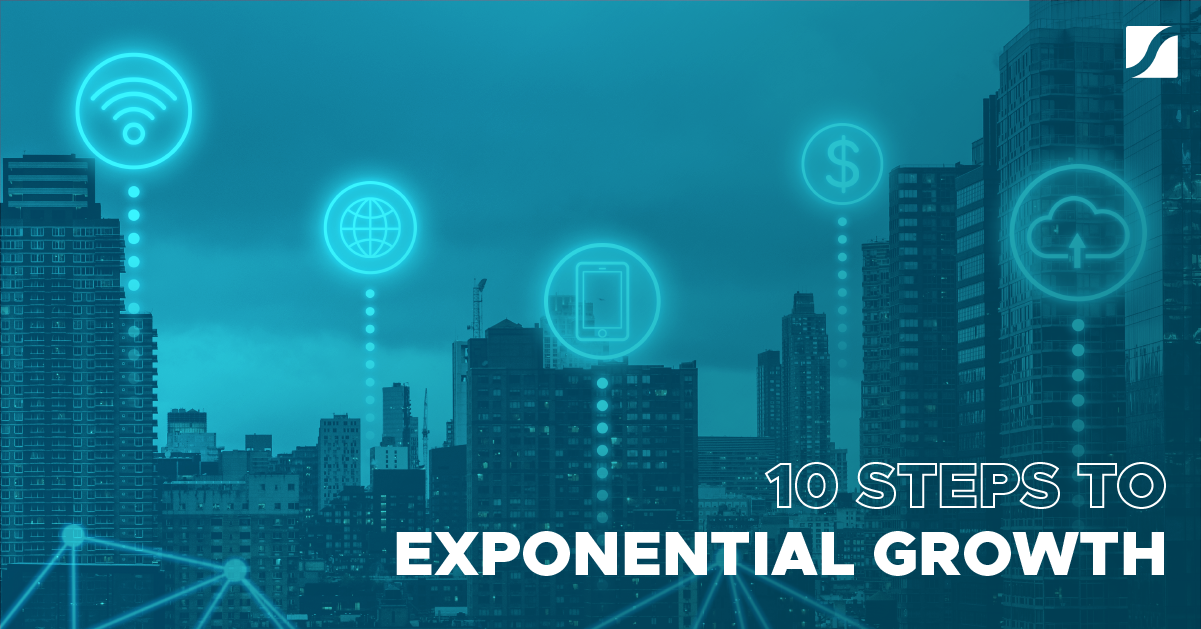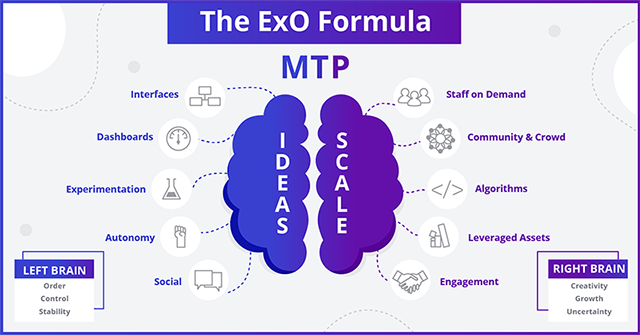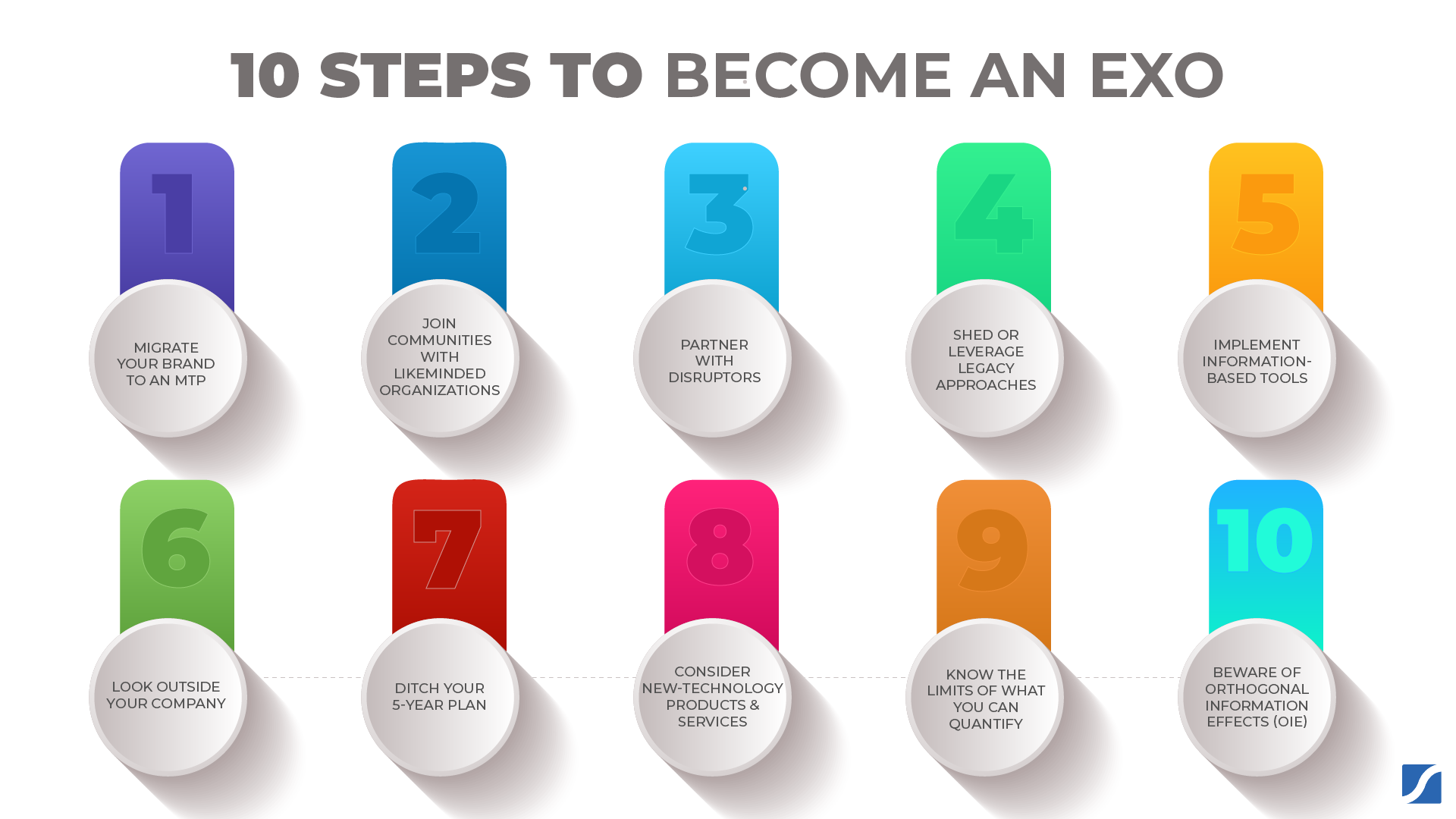10 Steps To Navigate Breakthrough Technologies And Achieve Exponential Growth


Two decades ago Blockbuster was flying high when fledgling Netflix made the company an offer to offer DVD and videotape rentals online.
Blockbuster ignored the overture and stayed the course. It believed it had cornered the movie rental market with its in-store approach and didn't need to adapt to what this startup was offering. Two years later Blockbuster was bankrupt.
And Netflix? That company that wasn’t worth Blockbuster’s time built on its innovative approach, going on to offer not only movies online but also TV shows and original productions to more than 200 million paid subscribers globally.
In the 21st century, you’re either the disruptor or the disrupted. You make the active choice to be the disruptor in the midst of information and technology breakthroughs — or you make the passive choice to be the disrupted. There is no middle ground. By the time passive Blockbuster realized its error, it was too late.
Blockbuster had become the disrupted.
What technologies and trends are we facing today that will leave your company with its own decision to disrupt or be disrupted? And how should you, as a business leader, respond in this world of information intelligence, hyper-connectivity, and rapidly changing technologies?
Current Disruptions That Could Spark Your Exponential Growth
From artificial intelligence to virtual reality, disruptions like the ones Netflix introduced years ago are facing us every day. Some businesses are better equipped to survive — and thrive — in the face of these technologies and trends. I studied more than 100 organizations — TED, Google, and Boston Children’s Hospital, for example — that have historically created 10 times more impact than their peers. And I discovered a new breed of successful organizations.
I call them exponential organizations, or ExOs.
In my book Exponential Organizations, I explore some of the disruptions facing today’s organizations — and how ExOs adapt to them. The technologies and trends companies now must navigate include:
Artificial Intelligence
Artificial intelligence (AI) and its subset processes machine learning and deep learning generate vast amounts of information. This data is driving an increasing number of business decisions and disrupting the way knowledge workers do their jobs.
Blockchain
Blockchain and the bitcoin cryptocurrency it supports are changing payment structures, contract signatures, voting systems, and audit processes. Micropayments and money transfers are disrupting how industries ranging from credit card companies to payment systems do at their work.
3D Printing
3D and 4D printing are disruptive forces with implications for manufacturing. The ability to print nearly anything could yield a new class of products whose effects on warehousing and transportation could revitalize the manufacturing industry in the United States.
Neurofeedback
Feedback loops can help the brain to focus. This disruptive force is allowing for the creation of applications that promote creativity, therapy, stress reduction, and focused learning.
Virtual Reality
Enhanced-quality virtual reality provides additional opportunities for remote viewing. Virtual reality is facilitating remote services, including those related to medicine and other expert help.
Sensors And The Internet Of Things
The explosion of Internet-connected devices and embedded sensors affects nearly all facets of life. Their presence in everything from wearables to packaging is fostering new models of business based on connected products that provide a plethora of data.
The Secret To Exponential Organizations’ Success
Leveraging and adapting to disruptions like those we face today is the name of the game for ExOs. They possess 11 attributes that set them apart from organizations that struggle to adapt to rapidly changing technologies:

Massive Transformative Purpose (MTP)
ExOs have a “why” that motivates them — a Massive Transformative Purpose (MTP). It describes a better future for your industry, your community, or even the world. An MTP isn’t a marketing slogan, but rather an aspirational tagline that tries to solve a global issue. A great MTP attracts the customers, community, partners, and resources you need to effect change.
Consider Google’s “Organize the world’s information” or TED’s “Ideas worth spreading,” for example.
Staff On Demand
An ExO minimizes full-time staff and outsources tasks when it can. In today’s information age, a large workforce can be an anchor that hinders quick maneuvering. Staffing on demand keeps a company’s staff agile, flexible, and cost-effective.
Community & Crowd
Businesses that build communities and make their actions public attract the right people. ExOs leverage community and crowd for many functions traditionally tackled within a company, attracting a healthy mix of ideas and funding and diverse views on design, distribution, marketing, and sales.
Algorithms
ExOs leverage data and algorithms to scale. With the data-driven landscape of today’s world, algorithms are a critical component of every business. The objectivity of this information makes it a critical driver for organizations committed to exponential growth.
Leveraged Assets
Renting, sharing, or leveraging assets — not owning them — is an approach ExOs take to easily offer and scale assets locally and globally. Think of Waze, which piggybacked off its users’ smartphones to create a GPS navigational tool that leverages another tool’s capabilities.
Engagement
ExOs rely on collaborative human behavior to encourage the results they want from their community. They offer the sweepstakes, quizzes, coupons, airline miles, and loyalty cards that have connected individuals and fostered loyalty for years. But they do so through social media, digital reputation systems, games, and other outreach platforms that take advantage of today’s information-enabled environment.
Interfaces
An ExO has a customized process for how it interfaces with customers and others. These types of interfaces often become the company’s defining internal characteristic, allowing the organization to filter out what doesn’t fit and scale. Apple, for example, has strict rules about what it includes on its app store.
Dashboards
Real-time dashboards make visible to everyone in an organization exactly what’s going on with essential company and employee metrics. Because ExOs grow at a rapid pace, the company needs visibility in all areas to allow for efficient assessments of the organization, teams, and individuals. Additionally, easy access to data makes potential problems clear and easier to correct before they grow into larger issues.
Experimentation
In today’s constantly evolving world, the biggest risk is not taking any risk. That makes regularly testing assumptions and experimenting with controlled risks so vital. As an ExO, Amazon, for example, has an “institutional yes” policy in which the default answer to an idea is a yes — and pushing boundaries is encouraged.
Autonomy
Small, independent, and interdisciplinary teams are key to a company’s growth and evolution. ExOs employ self-organizing teams with decentralized authority, which gives individual employees the autonomy to make decisions to rise to the level of service that’s central to the business’ culture.
Social Technologies
Social, or collaborative, technologies help companies manage real-time communication among all employees. ExOs rely on these technologies to provide an easier, faster, and more organized method for completing tasks and working together. Yammer, Slack, and instant messaging platforms add to an organization’s transparency and connectedness.
10 Steps To Tackle Today’s Disruptions As An ExO
Entrepreneurs, CEOs, and other business leaders facing information-based disruptions can lead companies in taking on the characteristics of an ExO. Here are steps you can take now to follow the lead of ExOs to leverage emerging trends — and adapt and grow.
1. Migrate Your Brand to an MTP
The first step is to migrate your brand to an MTP. Move beyond the traditional mission statement to one that is massive and transformative.
2. Join Communities With Likeminded Organizations
Find communities that represent the values of your organization and align with your MTP. Join those communities — or create them.
3. Partner With Disruptors
Your competition in today’s world will not come from other big companies — it will come from 2 guys in a garage leveraging exponential technologies. Find the disruptors in your community. Then partner with them, learn from them, invest in them, or acquire them.
4. Shed Or Leverage Your Legacy Approaches
Startups can operate with no marginal cost of supply and no marginal cost of demand. How will you compete? Navigating your current approaches to staffing and strategy and adapting them to accommodate changing technologies is critical.
5. Implement Information-Based Tools
ExOs leverage information-based products. Think about how you can take your existing set of products and services and either information-enable them or create a new line of products that capitalize on the use of information.
6. Look Outside Your Company
Peter Diamandis, our co-founder at Singularity University and a key adviser in writing Exponential Organizations, said, “If you’re relying on innovation solely from inside your company, you’re dead.” Today there’s too much happening outside of your organization to ignore it, so consider the innovation of your communities.
7. Ditch Your 5-Year Plan
Corporate 5-year plans are linear plans, not exponential plans. Think about morphing into an MTP, and then add a 1-year operating plan with fast-moving dashboards to give quick feedback about results.
8. Consider New-Technology Products and Services
What are the new products and services that might come from emerging technologies? Blockchain and Bitcoin are examples of entirely new business models that you could intersect with existing product or service suites. Create a team to explore radical innovations that can come from new technologies.
9. Know The Limits Of What You Can Quantify
Algorithms are a vital part of decision-making in ExOs. But don’t abandon your instincts, because quantifying data does have its limits. The gut feel in this age of information can be the unique differentiator. What has worked in the past might not be what works going forward, so give thought to the new world.
10. Beware Of Orthogonal Information Effects (OIE)
In computing, orthogonal refers to the use of data without consideration of its effects on other functions. In business, there’s not a single industry that doesn’t fall victim to the phenomenon of Orthogonal Information Effects (OIE).
Here's an example of what I mean: A successful entrepreneur and graduate of Singularity noticed that car washes in Buenos Aires had experienced a 60% drop in revenue. After closely examining a variety of factors, he found that in the last several years we’ve also gotten 60% better at computing predictions of when it’s going to rain — which allows people to be choosier about when they wash their cars. The lesson: Be flexible in adjusting to unexpected consequences that information intelligence can bring.
Achieve Exponential Growth In Today’s Disruptive Forces
Be the disruptor, not the disrupted.
With these 10 steps, you ensure that your business can engage in and leverage the wide range of today’s disruptions in intelligence, hyper-connection, and rapidly-growing technology.



